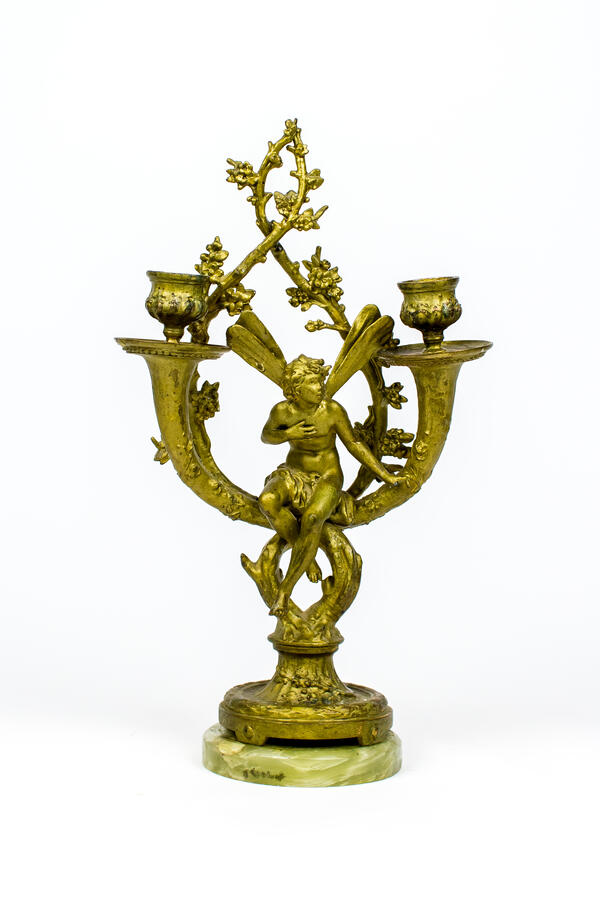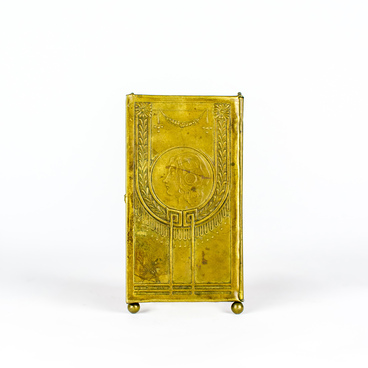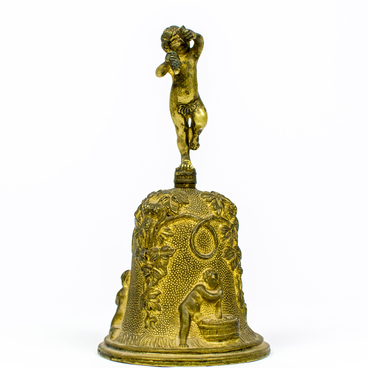The candelabrum presented in the exhibition was confiscated from the Tetyush merchants and handed over to the museum in the 1920s. The two-arm bronze candlestick depicts a Cupid sitting on the branches. The side branches are crossed at the bottom, in the upper part there are plates attached to them, into which candle bowls are screwed. The bronze base of the candlestick is attached to the marble stand by a metal rod.
The first candle stands appeared in ancient Egypt. According to the legend, the supreme sun god Ra first appeared to mortals in a lotus flower, in which a flame was burning. In his honor, the Egyptians began to make candlesticks in the form of this flower. They were made of reeds, clay and wood, and the tops were decorated with leaves. Such candlesticks were used in not only everyday life, but also as ritual attributes during various religious rites.
The first candelabrum, which could hold several candles at once, appeared among the Etruscans. They were tall candlesticks made of bronze in the shape of animal paws. The rod was fixed on a curly leg, and a socket with four candlesticks was placed in the upper part. The height of such candelabrum could reach one and a half meters.
In the Middle Ages, metal candlesticks and candelabrum were used mainly in temples, as well as in the homes of representatives of noble families. The poorer townspeople fixed candles in ordinary ceramic plates.
During the Renaissance, candelabrum became a popular interior decoration, so people began to pay more attention to their appearance. Candlesticks were most often made of bronze, strong and resistant to high temperatures, less often — of brass, silver and even gold.
Over time, many artists and sculptors began to work on candlesticks. They were decorated with relief carvings, sculptural compositions, and precious stones. Biblical and mythological subjects, landscapes and monograms were often used as decoration motifs. Porcelain candlesticks decorated with gilding and drawings are considered especially luxurious among antique items. Only royal families and very noble people could afford them.
The first candle stands appeared in ancient Egypt. According to the legend, the supreme sun god Ra first appeared to mortals in a lotus flower, in which a flame was burning. In his honor, the Egyptians began to make candlesticks in the form of this flower. They were made of reeds, clay and wood, and the tops were decorated with leaves. Such candlesticks were used in not only everyday life, but also as ritual attributes during various religious rites.
The first candelabrum, which could hold several candles at once, appeared among the Etruscans. They were tall candlesticks made of bronze in the shape of animal paws. The rod was fixed on a curly leg, and a socket with four candlesticks was placed in the upper part. The height of such candelabrum could reach one and a half meters.
In the Middle Ages, metal candlesticks and candelabrum were used mainly in temples, as well as in the homes of representatives of noble families. The poorer townspeople fixed candles in ordinary ceramic plates.
During the Renaissance, candelabrum became a popular interior decoration, so people began to pay more attention to their appearance. Candlesticks were most often made of bronze, strong and resistant to high temperatures, less often — of brass, silver and even gold.
Over time, many artists and sculptors began to work on candlesticks. They were decorated with relief carvings, sculptural compositions, and precious stones. Biblical and mythological subjects, landscapes and monograms were often used as decoration motifs. Porcelain candlesticks decorated with gilding and drawings are considered especially luxurious among antique items. Only royal families and very noble people could afford them.



